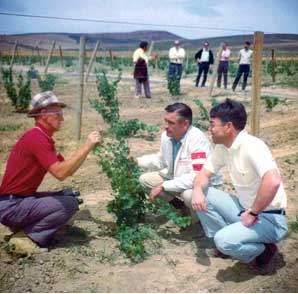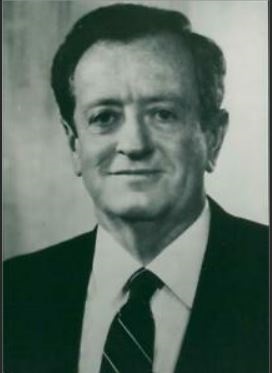But that wasn't enough for its parent company, Altria, headquartered in
Virginia. Despite owning the dominant wine company in the Pacific
Northwest, Altria is a giant tobacco company (yes, tobacco!),
whose brands include Philip Morris and Marlboro. Over the past several
years it has been making huge investments in new tobacco alternatives
like Juul; SMWE, the odd duck in its portfolio, could provide a revenue
windfall. When a private equity firm in Manhattan offered to buy its
wine business for $1.2 billion, Altria said yes.
But how did Altria come to own SMWE in the first place? In 2008, Altria
bought a modest, family-owned, smokeless-tobacco company (Skoal,
Copenhagen) called UST, and UST happened to own SMWE. And how did that deal come about? Half a century down the line, it still
seems improbable. Here, virtually ignored by Ste. Michelle's official
history, is the almost unknown story.
On February 23, 1973, two Seattle men disembarked from an overnight
flight on a TWA DC-8 Stratocaster and took a limo from La Guardia
airport on Long Island to Greenwich, Connecticut, some 30 miles
northeast along the north shore of Long Island Sound. The chairman of a
family-owned company that called itself United States Tobacco, a
courtly, 52-year-old gent named Louis F. Bantle, who had inherited the
company from his father, was expecting them.
 The Seattle visitors might have been cast as Mutt and Jeff in a black
& white comedy. Joel Klein was six feet, six inches tall,
soft-spoken, and serious. Wally Opdycke had a shock of curly black hair
but stood almost a foot shorter, ebullient, with mischievous eyes.
Bantle offered his visitors a Kool from his silver cigarette case, but
they declined. Bantle's company marketed Copenhagen and Skoal smokeless
tobacco and had an 80 percent market share. Bantle's innovation at US
Tobacco was the creation of flavored Skoal sticks, which at one point
were used regularly by 40 percent of American males under the age of
25. "Before you go, you boys have got to see the museum," Bantle said.
That would be the two-story brick colonial house in front of the sleek
office building that housed UST. On display inside were cigar-store
Indians, spittoons, hookas, and a three-foot Meerschaum pipe. "I'll bet
that drives Dr. Koop nuts," Klein said, referring to the U.S.
Surgeon-General, a lifelong crusader against tobacco.
The Seattle visitors might have been cast as Mutt and Jeff in a black
& white comedy. Joel Klein was six feet, six inches tall,
soft-spoken, and serious. Wally Opdycke had a shock of curly black hair
but stood almost a foot shorter, ebullient, with mischievous eyes.
Bantle offered his visitors a Kool from his silver cigarette case, but
they declined. Bantle's company marketed Copenhagen and Skoal smokeless
tobacco and had an 80 percent market share. Bantle's innovation at US
Tobacco was the creation of flavored Skoal sticks, which at one point
were used regularly by 40 percent of American males under the age of
25. "Before you go, you boys have got to see the museum," Bantle said.
That would be the two-story brick colonial house in front of the sleek
office building that housed UST. On display inside were cigar-store
Indians, spittoons, hookas, and a three-foot Meerschaum pipe. "I'll bet
that drives Dr. Koop nuts," Klein said, referring to the U.S.
Surgeon-General, a lifelong crusader against tobacco.
Walter clore (left), Wally Opdycke (right)
Opdycke and Klein had not come to talk to Bantle about tobacco,
however, but about wine. Until the previous year, Opdycke had been a
math whiz who worked as a business analyst for Safeco Insurance, which
was headquartered in Seattle. Looking for safe investments, Opdycke
came upon a rundown company in a south Seattle warehouse called NAWICO,
the North American Wine Company, which had not succumbed to Prohibition
and still held a federal license to produce alcohol. Opdycke wrote a
business plan for Safeco to buy the winery, which had been making fruit
wine, and get into the fine wine business like Mondavi in California.
There was, Opdycke had heard, a PhD professor named Walter Clore who
was going around eastern Washington urging hop farmers and cherry
orchardists to uproot their orchards and plant grape vines instead.
Safeco executives were not impressed, however, and turned Opdycke down.
But Opdycke was convinced of his plan's merits. He sent in his
resignation, rounded up a few friends (among them, super-lawyer Mike
Garvey), and bought NAWICO for himself. He knew he'd need a
professional wine maker, and asked the dean of the only American
university that trained people in the science of fermentation: the
University of California at Davis, whose program was known as Budweiser
U. That's where Opdycke found Klein, who moved to Seattle in 1975.
The realities of the marketplace soon made it clear that Opdycke would
not be able to carry out his plans to start a winery on his own. For
one thing, there were very few locally grown wine grapes available. For
another, the facilities in south Seattle left much to be desired. But
Opdycke had a plan. The federal agency which regulated alcohol also
regulated tobacco, the Bureau of Alcohol, Tobacco and Firearms. So
Opdycke had read up on tobacco companies, which, it turned out, made
huge profits. They could afford to spend millions of dollars on
marketing, advertising, promotions, and sponsorships because the
margins on their products were astronomical. Insurance companies were
satisfied with two and three percent return on their investments
because they needed to be safe and predictable. The cost of production
for tobacco companies was minuscule by comparison; a two-dollar pouch
of Copenhagen cost Bantle seven cents to manufacture. In 1971, the year
before Opdycke came calling, US Tobacco had net profits of $250 million
on sales of $650 million.
The surprise, today, is that this wasn't more widely known, but US
Tobacco, one needs to remember, was privately held and didn't need to
disclose its operating statements. Tobacco stocks that were listed on
the New York exchange were high fliers: Philip Morris, JP Lorillard,
British-American Tobacco.
 Klein did a show-and-tell for Bantle, using objects from his desk, to
demonstrate the tilt of the earth, its rotation relative to the sun,
and the result: during the growing season, the higher latitudes of the
Yakima Valley get more daylight hours than Bordeaux or Burgundy, or
even California's Napa Valley, and it is sunlight, not heat, that
matures the grapes. Yes, winters get really cold, and the vine goes
truly dormant, but then it comes back the following spring with
astonishing vigor.
Klein did a show-and-tell for Bantle, using objects from his desk, to
demonstrate the tilt of the earth, its rotation relative to the sun,
and the result: during the growing season, the higher latitudes of the
Yakima Valley get more daylight hours than Bordeaux or Burgundy, or
even California's Napa Valley, and it is sunlight, not heat, that
matures the grapes. Yes, winters get really cold, and the vine goes
truly dormant, but then it comes back the following spring with
astonishing vigor.
Louis F. Bantle
Opdycke talked numbers: fifty million dollars or so to buy land and
plant vineyards, another fifty million or so to build new facilities (a
showplace headquarters close to Seattle, production facilities adjacent
to the vineyards). They would soon realize you can't push wine through
a pipeline, they would need to build a nationwide sales and
distribution network to create demand and suck out the juice. (Another
fifty million or so.) Bantle began nodding appreciatively. But he
didn't want to write a check for $100 million; he wanted to buy the
company. For half a year's worth of the company's annual profits, UST
would dominate a new industry. By the time Opdycke and Klein got back
in the limo, they had a deal.
"You effing did it!" one imagines Klein high-fiving Opdycke in the
parking lot. "You got this tobacco dude to underwrite the entire
Northwest wine industry!" (Four decades later, then-CEO Ted Baseler
reiterated this: "Ste. Michelle created the Washington wine industry
with UST cash," he told me.)
When the Port of Seattle needed to expand soon thereafter and exercised
its right of eminent domain to take over the old Pomerelle facility in
South Seattle, Opdycke was not worried. He had his eye on an 85-acre
property called Hollywood Farm, outside a bedroom community,
Woodinville, east of Lake Washington. It had belonged to Frederick
Stimson, the timber baron, and was now for sale. Here Opdycke would
build a European-style showplace for his winery, Chateau Ste. Michelle.
(Why "Ste. Michelle"? It was Opdycke's daughter, the story goes, who
said it was high time to name a winery "for a girl.")


